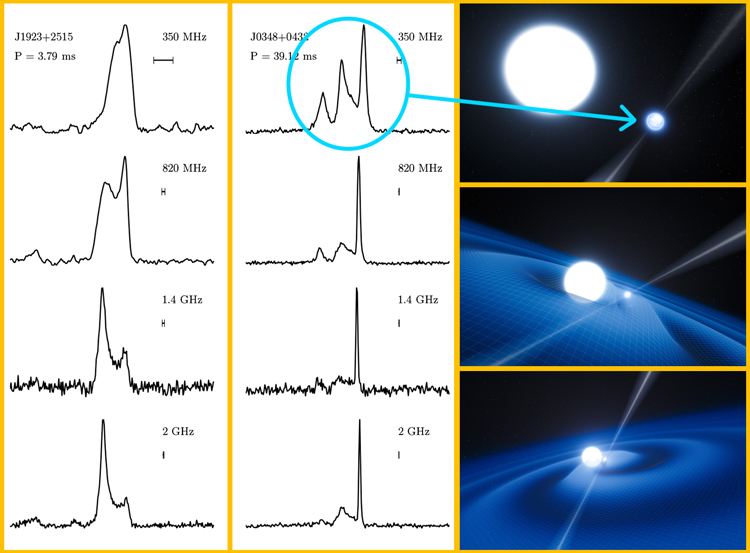| Description: | In 2007 a global team of astronomers including ASTRON scientists Hessels, Kondratiev and van Leeuwen used the Green Bank Telescope (USA) for a 1,000-hr, 10,000-sq. degree pulsar survey (Paper I, ApJ 2013). This 350-MHz GBT 'drift-scan' pulsar search discovered 31 new pulsars, 7 of which are recycled pulsars. Notable systems, described in paper II, ApJ 2013, include PSR J2222-0137, a 32.8 ms pulsar at a very low DM of 3.27 pc/cc, which is in a 2.4 day orbit with a minimum companion mass of 1.11 M sun. It is most likely a white-dwarf-neutron-star system or an unusual low-eccentricity double neutron star system. PSR J1923+2515 is an isolated MSP with a 3.8-ms spin period (left panel). Finally, PSR J0348+0432 (middle panel) is a partially recycled pulsar with a white dwarf companion in a short orbit.
From follow-up optical observations, that latter millisecond pulsar, J0348+0432, turned out to a very massive, 2.01 solar mass neutron star in a highly relativistic orbit (artist impressions, right-most panel; Paper III). The high pulsar mass and the compact orbit make this system a sensitive laboratory of a previously untested strong-field gravity regime; a results that warranted publication in Science recently. Many physically motivated extensions to general relativity (GR) predict significant deviations in the properties of spacetime surrounding massive neutron stars. Thus far, the observed orbital decay agrees with GR, supporting its validity even for the extreme conditions present in the system. The resulting constraints on deviations support the use of GR-based templates for ground-based gravitational wave detectors. Additionally, the system strengthens recent constraints on the properties of dense matter and provides insight to binary stellar astrophysics and pulsar recycling. The press release for this paper includes a dynamic video impression of this extreme system. |

